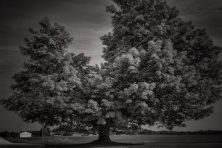Suzanne Rose on Documenting Our Blind Spot
- Share
- Tweet
- Pin
- Share

Suzanne Rose examines our impact on nature in Miller exhibit
In her show of large, stunning, black-and-white photographs at the Miller Art Museum in Sturgeon Bay, Suzanne Rose shows the impact of humans on nature, and occasionally the opposite: nature taking over abandoned buildings.
Titled Blind Spot: To Pass among Them, the show highlights sad heroes such as majestic trees that have had big bites taken out of their sides or centers to make way for electrical lines. In another striking image, tall steel towers carrying high-tension power lines make a 90-degree turn on their way through woods.

“The project began as a thematic approach to photograph the ‘unseen and overlooked’ – the blind spots in the landscape that are either intentionally or unconsciously avoided by averting one’s gaze,” Rose wrote. “I had decided very early on that land use and misuse were to be the topic. I saw an unusual beauty in damage that I wanted to explore photographically.”
In the museum’s back gallery, she depicts nature fighting back: three photographs of abandoned buildings being overgrown by trees crowding against their walls.
The Museum of Wisconsin Art in West Bend showed this work from late 2021 into 2022 and bought a portfolio of 30 of Rose’s prints. It is now sending the collection on tour, and the Miller Art Museum – which will show the work through Sept. 9 – is its first stop.
Rose is using the latest digital tools to re-create the quality of mid-19th-century West Coast photographers such as Carleton E. Watkins, who used a camera with 18-inch-by-24-inch glass plates. She shoots with a 43-megapixel Sony, the largest digital sensor available in a 35mm-size camera.

Rose has studied the transition from film to digital with several mentors, including Daniel Anderson in Ellison Bay, and she makes extensive use of Adobe Photoshop: software used for processing and designing with photographs.
“If you’re not using Photoshop, you’re not artistically engaged in your modern work,” she said. “I strongly believe that Photoshop is a necessity.”
Rose has a standardized workflow for the aesthetic for this entire series.
“I strive to make prints; I am a photographer who prints,” she said. “I’m really looking to create a consistent body of work that has a unified mood and aesthetic, and that’s done by a very set recipe that gets me to that final point. It’s very complicated. Photography has evolved beyond the darkroom, and we’ve evolved into an age where we have scalpel-like control, and that’s what I’m after.”
Rose’s underlying concern is the Anthropocene epoch, generally viewed as a period that started with the Industrial Revolution in the late 1700s and early 1800s – a time when human activity began influencing the climate and environment, and production moved from artisans to machines and factories, often powered by coal. Photography appeared at roughly the same time, coming into fairly widespread commercial use during the 1850s and 1860s.
The favorite subjects of photographers of the time, besides portraits, were images of wilderness and also pioneering industry. They were making images for the growing tourist business and also for the owners of mines and sawmills. Sometimes the two overlapped, such as in commissions by railroads to photograph rails and trains, as well as the scenery they passed through, to attract travelers.
Much of Rose’s work is about the unintended consequences of development, carelessness or simply not caring about the impact on nature. Although her images capture the rawness of destruction, the photographs themselves are exquisite.

She wants to attain the quality that those early photographers produced in both the photograph and its presentation, so she makes 40-inch-wide prints framed in eight-ply mats that provide what she described as an
Old World museum quality.
“I did a deep dive into first photography, and first photography had a specific presentation aesthetic,” Rose said.
Rather than displaying prints framed only in rectangular-cut mats, early photographers used arched mats to crop skies, which tended to get blown out because they were using large-format cameras and exposing for shadows, she said. Rose also uses oval shapes and sometimes circles in the thick, eight-ply mats, but it took her several tries to find someone who could cut those difficult shapes cleanly.
Several museum visitors commented on the sepia toning, but it’s actually her own formula, which draws on digital swatches of 19th-century photographers’ prints that the Getty sent to her.
“Then I whipped up a batch of my own toner,” Rose said. “I primarily looked to the work of Carleton E. Watkins, Timothy H. O’Sullivan, William Bell, William Henry Jackson and Gustave Le Gray. The final toning I applied to my images is a hybrid influence of them.”
The toning is entirely digital, but to check her work against the original quality that she was seeking to re-create, she made an appointment to view some 19th-century prints in Chicago in the Art Institute’s photography collection. She received permission to take her own prints to set them side by side with the vintage prints. Rose asked for work by 17 photographers, including Sally Mann, a contemporary American who made a Deep South series; and Josef Sudek, a Czech photographer.
Early mines and factories in 19th-century photographs were barely holding on in the wild, where development is set in small clearings amidst vast forests. A century and a half later, machine-powered industrialization has overwhelmed nature, and Rose is asking what is necessary, what is too much and perhaps what should be preserved.
In her artists’ statement, she wrote: “Once vital and sacred – mounds, piles and stacks represented work ethic, subsistence and honor. Now, outsized and overreaching, mounds have become a distilled symbol of the ongoing sprawl, mass harvest and dissipation. They stand as testimony to the impact of current consumption and waste that are unsustainable.”
It took her about a year of shooting to choose a focus.
“Over a period of a year,” Rose wrote, “I photographed the manipulated landscape – new roads, sprawl and the removal of wooded areas for homes – and the industries responsible, such as saw mills, cement factories, big farming and disposal sites. But as I traveled and collected a large range of photographs, aesthetically the project did not hold the intimacy I was in search of.”
Then Rose narrowed her focus to the impact that humans have had on nature. It was a smart choice because agribusiness or industry could have become political, and deer stands alone might have been a bit precious. Also, as she said during her talk at the Miller Art Museum, urban audiences often have no idea what a deer stand is.
“It became clear that, visually, the images were spread too thin. I needed density to convey the weightiness of the topic,” Rose said in an artist’s statement. “It was that pivotal concept that led me to condense my subject from a vast collection of actual sites to a tidy collection of symbolic identifiers: trees, deer stands, mounds and overgrown agrarian buildings.”
Rose chose to show in quietly powerful pictures the impact that development has on nature – but that was just the beginning. She said she’s also on a personal quest to understand – and minimize – her own impact on the earth, which is a difficult balance. Although she has several pictures of gravel piles, for example, she is not against gravel.
“Living in Door County, I am constantly driving,” Rose said, so she appreciates good roads and the salt spreaders that make them usable during the winter. “I just want to understand my place in the chain of events. I want to find the balance because I’m going to continue to consume. I need to eat. I need to stay warm. I need to stay cool. And I live in an area where I want to play as hard as I work.”


